The Mandolin
by Vincenzo Schisano
(Translated by Marianna Mastro)
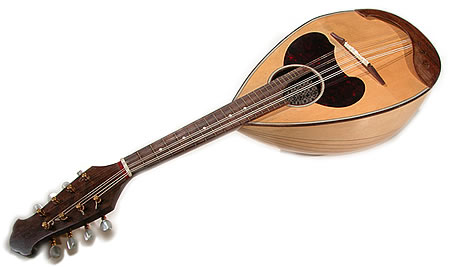
The mandolin has a pear shaped sound box, which is deep and pot-bellied, an oval sonority hole, a short neck with metallic strings, the peg is shaped like a spatula and slightly inclined backwards, the pegs are situated on the sides in the ancient models and behind in the modern models, the chords are of steel, (of catgut or brass in the less recent ones) and are pinched by a plectrum (that may be of many shapes) of turtle shell or whalebone, of horn or in the more recent models, of plastic.
The chords which are double, are 4, tuned like the violin: mi-la-re-sol.

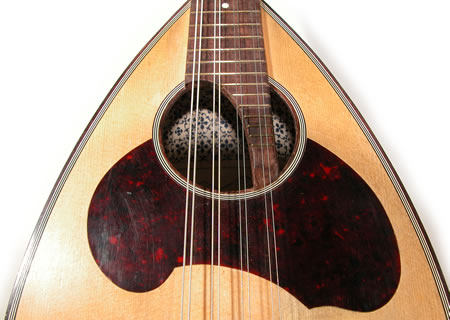
There are various models of mandolin:
- the “classic Neapolitan”;
- the “Milanese” ( with a not very deep music box and 6 chords);
- the “Roman” (with a curled neck and the capotasto more elevated);
- the “Sicilian” (with double chords on the bass and triple
in the high notes);
- the “Paduan” (with 5 double chords and a small music box);
- the “Sienese” (with 4/6 simple chords);
- the “Florentine” (with a large neck and 5 types of chords);
- the “Genoese” (with the peg shaped like a sickle and 5/6 simple
chords).
The origin of the Neapolitan mandolin dates back to the 17th century; at that time, in fact, the “CasaVinaccia” manufacturer factory begins the production.
The first mandolins had chords made of gut, the pegs were made of wood with an extension limited to the “RE” note above the staff with two cuts in the neck. Later on, the keyboard was extended to the “LA” above the staff with five cuts in the neck.
These instruments were adorned with inlaid wood works and ivory trimmings; the sound box had from 15 to 20 grooves.
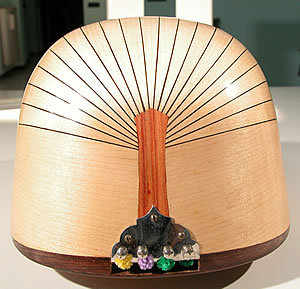
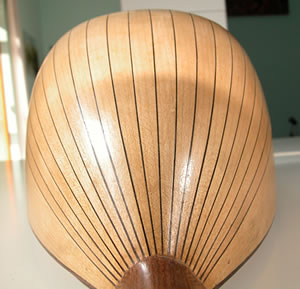
In the following epoch, thanks to the Vinaccia manufacturers, the chords made in gut were substituted with the chords made in steel, and the successor Pasquale Vinaccia, invented the mechanism which is still used today, obviously improved, used for the regulation of the tension of the chords, which makes the tuning much easier.
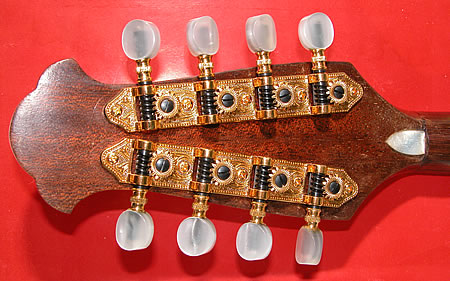
The manufactuer “Calace” applied the following innovations:
the shell shaped sound box; a covering which isolated the sounding board
from the player’s arm, the hole with a straight side; a different
type of shield, the keyboard in black and white; two holes above the bridge
for the
sonority; the sound board dark and shiny; a pyramidic paddle; chord pins
with 8 buttons for the
independence of the chords; a cantabile lute with 5 chords (mi – la – re – sol – do)
and a keyboard extended to 24 or 29 keys.
Usually in the manufacturing of good mandolins are used selected
and fine quality woods:
- for the sound box is used the maple or the rosewood;
- for the neck is used the rosewood or the ebony;
- for the keyboard is almost always used the ebony;
- for the trimming between the (ribs) false notes is used the beech-wood.
The ribs forming the sound box vary from 17 to 33; in the better instruments they are fluted (that is concave) and often tied by steel trimmings (in those of great value).
To adorn the neck and the sound board are used inlaid ornaments of ivory, turtle, celluloid, or mother of pearl, for the paddle is shaped a “curl” in which is sculptured the head of a person or an animal.
All the parts of the mandolin are polished with a mixture of alcohol, rubber and lacquer, only the sound box is not polished to limit the transmission of the vibrations and therefore of the sound.
To sum up, the Neapolitan mandolin is composed of:
- a wood sound box shaped like a half pear;
- the sound box has an opening called “rosa”;
- the neck is integrated with the keyboard;
- the paddle in which is inserted the mechanism for the tension of the chords;
- the chords, which are 8, tuned in unisonal every two, which produce the
following sounds: mi, la, re, sol.
Before the chords are fixed to the mechanism, they are set on the “capotasto”; in the lower part instead, they are set on the “bridge” (a small ebony piece on which is applied a bone border), before they are tied to the sound box with small bone buttons (or brass buttons) or with a steel plaque with 8 hooks.
The diameter of the chords (of steel often coated with a thread of silvered copper) increases as it goes towards the grave.
Very important mandolin manufacturers have been: the Vinaccia brothers and heirs, the Maratea brothers, Pasquale and Gaetano Esposito, Raffaele Calace and his descendants, Carlo Loveri, Gennaro Rubino, Antonio Ranaldi, Luigi Ricci and Alessandro Abbate.
The following have written mandolin
pieces: Munier, R. Calace, Marucelli, Mezzacapo, Pietrapertosa,
W.A. Mozart (Don
Giovanni), G. H. Verdi (Otello),
P.A. Tasca (A Santa Lucia), M. Costa (Histoire d’un Pierrot),
N. Spinelli (A Basso Porto), E. Sartia (Il Babbeo e L’Intrigante),
Q: Valverde (Los Cocineros), G. Pietri (Acqua Cheta), G. F. Haendel
(Alexander Balus),
A. Vivaldi (Concert for mandolin and orchestra – 2 Concerts for
mandolin and orchestra), L. Van Beethoven (2 Sonatine – Adagio
and Andante with variations for mandolin and piano), G. Mahler (VII
Sinfonia),
Wolf Ferrari (The curious women – the
jewels of the Madonna), M. de Falla (La vida breve) G. Paisiello (The
barber of Siviglia),
I Stravinskij (Agon), A. Schoenberg (Serenata op. 24) and e P. Casella (The
concert of Venice).
© Copyright 2003 Vincenzo Schisano. All rights reserved.
